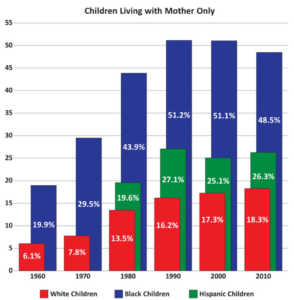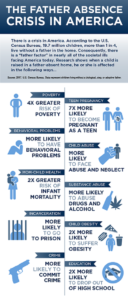A Father’s Absence
A Father’s Presence Can Positively Impact A Black Child’s Education:
A Call to Action for Gwinnett County

A White Paper
by
James A. Taylor, PhD
Wandy W. Taylor, EdD
July 2019
A Father’s Presence Can Positively
Impact A Black Child’s Education:
A Call to Action for Gwinnett County
Introduction
Over one hundred years ago, George Washington Carver made us aware of the essence of true freedom with this quote: “Education is the key to unlock the golden door of freedom.” Over the course of the past century, there have been ongoing efforts in America to deny and suppress opportunities for people of color to receive a quality education. Some of those efforts have involved passing racist legislation to create “separate and unequal” schools and using discriminatory disciplinary practices to eliminate children of color from public education.
Unfortunately, many parents of color have either wittingly or unwittingly contributed to the closing of the “golden door of freedom” (education) for their children. In the early 1960’s, many researchers became interested in the impact of a father’s absence on the educational development of their children. Black children became of interest because of the disproportionate number of black fathers who were either incarcerated or had to leave their families to seek employment in another geographic location.
Research Findings
- Mavis Hetherington was among the first social researchers to express an interest in the dynamics of a father’s absence on a child’s social and emotional development. In 1972, she noted that ten percent (10%) of the children in the United States were raised in broken homes that lacked the presence of a father, primarily due to a divorce. Hetherington’s findings suggested that father-absence appeared to be associated with a wide range of disruptions in a child’s social and cognitive development. The effects seemed to be more severe if the father was absent during the child’s preschool years, especially with boys.
While Hetherington’s research was intriguing, it generated more questions than answers regarding the impact of a father’s absence. In particular, she did not address the “race” factor in her research. It seemed as if the vast majority (if not all) of the children she studied were white females. Intuitively, given the social and economic disparities in America’s society in 1972, it would seem plausible that the impact of a father’s absence would not be the same for black as compared to white children.
At the turn of the century, many researchers began to focus on the impact of a black father’s absence on his children, especially when he was incarcerated. In their comprehensive report, Morsy and Rothstein (2016) concluded that the discriminatory incarceration of African American parents has a debilitating effect on their children and contributes significantly to their low performance in school.
The Father-Absence Crisis in America
Let’s be clear. We have a father-absence crisis in America today and it is having a huge adverse impact on our children, especially children of color (see Table 1).
Table 1

The figures in Table 1 were taken from the 2010 U. S. Census Bureau data. As indicated in the table, since 1960, black children have consistently represented the highest percentage of children living in a mother-only household. This dynamic has placed them at a higher risk for the social, health, and educational ills that are presented in Table 2.
Table 2

A Call to Action for Gwinnett County
If the adverse effects of a father’s absence have created an ongoing national crisis, let’s not fool ourselves into thinking that this crisis does not exist in Gwinnett County. It does! For too long, men of color have remained “absent” while the school system has wreaked havoc on our children. Children of color in Gwinnett County are disciplined, retained, detained, arrested, and dropout of school at a much higher rate than their white peers.
As indicated in this paper, the effects of a father’s absence can have a debilitating impact on a child’s (especially a boy’s) social and educational development. Also, there can be many reasons for father-absent families such as separation; incarceration; divorce; occupational demands; military service; and death. However, we cannot allow any reason for a father’s absence to impede the educational growth of our children. Any caring man can be a father figure and be willing to lend a “helping hand” to save our children, especially our embattled young men.
Given the current state of affairs in Gwinnett County, there is an immediate and urgent call for us to act on behalf of our children. This is what can and needs to be done by the following key entities in our community:
- Black Men. As a group, black men must “reappear”, let their voices be heard, and reclaim their status as much-needed support systems for our young men. Fraternal and advocacy organizations such as the 100 Black Men and Black Men United for Children & Humanity (BMUCH) can play a huge role in the socio-educational development of our embattled young men by providing support such as:
- Mentoring
- Tutoring
- Developing Leadership Programs
- Advocating for children of color
- Engaging the business community to seek support for efforts that are designed to improve opportunities for young black males.
- Faith Community. Ever since the days of the Civil Rights Movement, the church has been the most powerful and influential change-agent in our society. Now, more than ever, our faith community must provide the spiritual and civic leadership that is needed to facilitate the social, emotional, and educational development of our children of color. There is a clarion call for the faith community to:
- Engage local law enforcement agencies to ensure the fair treatment of our children.
- Host opportunities to engage the community in open discussions related to the socio-emotional development of our at-risk or father-absent children.
- Develop a standard “curriculum” that can be used by all churches to facilitate the social, emotional, and spiritual development of the at-risk boys in their congregation.
- Parental Involvement. The parent is a child’s first and most important teacher. When parents are involved in the educational process, their children thrive. Examples of parental involvement may include but are not limited to the following:
- Visibility
- Be there
- Be attentive
- Be supportive
- Keep promises
- Communication
- Talk to your children
- Listen to your children
- Encourage your children
- Build on their strengths
- Engagement with your children
- Reading
- Playing
- Coaching
- Volunteer at your child’s school
- Get to know teachers and administrators at the school
- Board of Education. As elected officials, it is incumbent upon the school board to exert the leadership that is needed to remove barriers that impede the educational development of our most at-risk students. The school board must do the following to improve educational opportunities for at-risk children of color:
- Develop a 5-year strategic plan with measurable goals to address the dropout rate and disproportionate suspension of children of color.
- Become more accessible to their constituents.
- Eliminate the over-use of police involvement in student discipline.
- Invest in early childhood education to improve the kindergarten readiness of at-risk children of color.
- Other Elected Officials. Our elected officials must have a platform to improve education for all children, especially those who are most at-risk. Elected officials such as Rep. Donna McLeod, Commissioner Marlene Fosque, and Rep. Gregg Kennard have made a difference in Gwinnett County. They have visited schools; engaged and listened to their constituents; and served as advocates for all children. All elected and aspiring-elected officials are challenged to follow their example.
Conclusion
In this paper, we have highlighted the negative aspects of a father’s absence on his children’s development. To be sure, there are many fathers who are not absent and whose presence has a positive impact on their children’s social, health, and educational development. When fathers are present, children (especially boys) are more likely to complete school and are less likely to enter a life of crime.
According to the 2010 census, 48.5% of black children in America lived in a mother-only household. Currently, the federal government is printing forms to gather information for the 2020 census. This raises two key questions: (1) Will a significant percentage of black children continue to live in a mother-only household? (2) Will children in those mother-only households continue to be at a greater risk of dropping out of school and living in poverty?
As residents of Gwinnett County, we cannot sit idly and allow any of our children to be denied access to a quality public education. Educating our children is a shared responsibility. Therefore, the key entities in our community (i.e., black men, churches, educators, elected officials, and parents) must work together to remove any and all barriers that could potentially keep any child from reaching his or her full potential. If we truly want to “unlock the golden door of freedom” for all children, then we must realize that we all hold the key to their success. By working together, we can mitigate the impact of a father’s absence and develop a generation of future leaders to steer Gwinnett County to even greater heights of excellence.
References
Hetherington, E. Mavis, 1972. Effects of father absence on personality development in adolescent daughters. Developmental Psychology 7: 312-326.
Morsy and Rothstein (2016).
https://www.epi.org/publication/mass-incarceration-and-childrens-outcomes/
Taylor, Jim. (2018). From Unequal to Unwanted: Reforms Needed to Improve K-12 Public and Higher Education in America. ISBN: 978-11-4575-6114-6.
https://www.tandteducationconsultants.com/
US Census Bureau, “Living Arrangements of Children Under 18”: Tables –CH-2, CH-3, CH-4. 1960 – Present. U.S. Census Bureau July 1, 2012. https://www.census.gov/data/tables/time-series/demo/families/children.html



